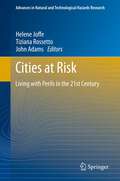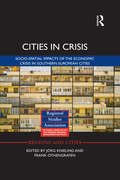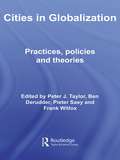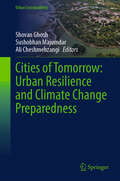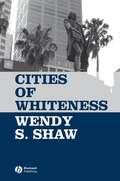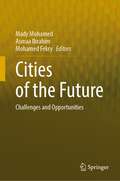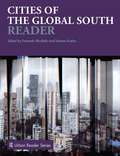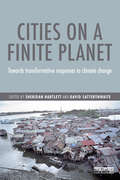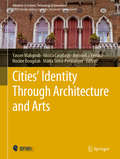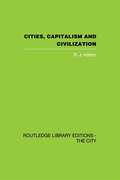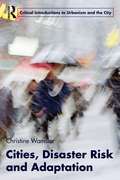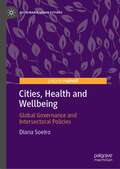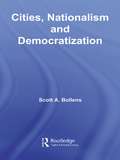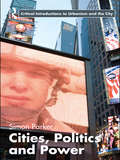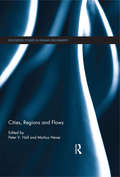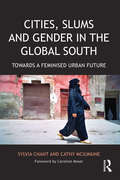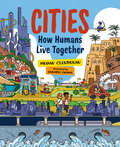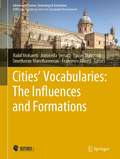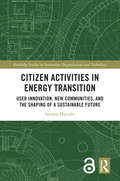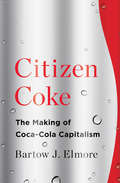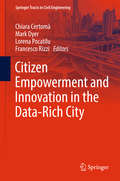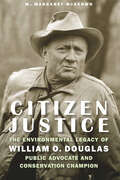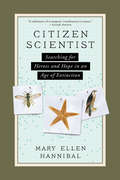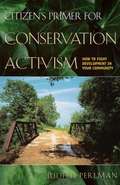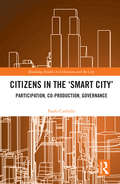- Table View
- List View
Cities at Risk: Living with Perils in the 21st Century (Advances in Natural and Technological Hazards Research #33)
by John Adams Tiziana Rossetto Helene JoffeWith the major growth of the world's population over the past century, as well as rapid urbanisation, people increasingly live in crowded cities. This trend is often accompanied by proliferation of poorly built housing, uncontrolled use of land, occupation of unsafe environments and overstretched services. When a natural hazard strikes such a city many people are vulnerable to loss of life and property. This book explores what these people think and feel about the threats that they face. How do they live with perils ranging from earthquakes to monsoons, from floods to hurricanes, in the 21st century? The authors are drawn from a large range of disciplines: Psychology, Engineering, Geography, Anthropology and Urban Planning. They also reflect on how perils are represented in multiple cultures: the United States, Japan, Turkey, Bangladesh, the United Kingdom and New Zealand. The book therefore not only brings to light the ways that different cultures represent natural hazards but also the different ways in which various disciplines write about living with perils in the 21st century. The book is addressed both to researchers and to organizations involved with risk management and risk mitigation.
Cities in Crisis: Socio-spatial impacts of the economic crisis in Southern European cities (Regions and Cities)
by Jörg Knieling Frank OthengrafenIn recent years, European societies and territories have witnessed the spatial impacts of a severe financial and socio-economic crisis. This book builds on the current debate concerning how cities and urban regions and their citizens deal with the consequences of the recent financial and socio-economic crisis. Cities in Crisis examines the political and administrative implications of austerity measures applied in southern European cities. These include cuts in local public spending and the processes of privatization of local public assets, as well as issues related to the re-scaling, recentralization or decentralization of competencies. Attention is paid to the rise of new ‘austerity regimes’, the question of their legitimacy and their spatial manifestations, and in particular to the social consequences of austerity. The contributions to this book lay the foundation for recommendations on how to improve and consolidate qualified governance arrangements in order to better address rapid economic and social changes. Such recommendations are applicable to cities and urban regions both within and outside of Europe. It identifies possible approaches, tools and partnerships to tackle the effects of the crisis and to prepare European cities for future challenges.
Cities in Globalization: Practices, Policies and Theories (Questioning Cities)
by Peter J. Taylor Ben Derudder Frank Witlox Pieter SaeyDespite traditionally being a strong research topic in urban studies, inter-city relations had become grossly neglected until recently, when it was placed back on the research agenda with the advent of studies of world/global cities. More recently the ‘external relations’ of cities have taken their place alongside ‘internal relations’ within cities to constitute the full nature of cities. This collection of essays on how and why cities are connecting to each other in a globalizing world provides evidence for a new city-centered geography that is emerging in the twenty-first century. Cities in Globalization covers four key themes beginning with the different ways of measuring a ‘world city network’, ranging from analyses of corporate structures to airline passenger flows. Second is the recent European advances in studying ‘urban systems’ which are compared to the Anglo-American city networks approach. These chapters add conceptual vigour to traditional themes and provide findings on European cities in globalization. Thirdly the political implications of these new geographies of flows are considered in a variety of contexts: the localism of city planning, specialist ‘political world cities’, and the ‘war on terror’. Finally, there are a series of chapters that critically review the state of our knowledge on contemporary relations between cities in globalization. Cities in Globalization provides an up-to-date assembly of leading American and European researchers reporting their ideas on the critical issue of how cities are faring in contemporary globalization and is highly illustrated throughout with over forty figures and tables.
Cities of Tomorrow: Urban Resilience and Climate Change Preparedness (Urban Sustainability)
by Ali Cheshmehzangi Sushobhan Majumdar Shovan GhoshThis book takes a comprehensive and forward-looking approach to urban resilience and climate change preparedness. It combines theoretical insights, practical case studies and innovative strategies to address the complex challenges cities face in an era of rapid urbanisation and changing climate patterns. It presents a fresh and innovative approach to addressing the intertwined challenges of urban resilience and climate change preparedness. What sets this book apart is its emphasis on forward-looking strategies, multidisciplinary insights and a comprehensive exploration of cutting-edge technologies and collaborative approaches. This book is likely to be diverse, encompassing professionals, academics, researchers, policymakers, practitioners, students and individuals interested in the fields of urban planning, environmental science, sustainability, climate change adaptation and related disciplines. The book aims to appeal to both experts in the field and those new to the subject, providing a valuable resource for different audiences.
Cities of Whiteness (Antipode Book Series #27)
by Wendy S. ShawThis groundbreaking book brings the study of whiteness and postcolonial perspectives to bear on debates about urban change. A thought-provoking contribution to debates about urban change, race and cosmopolitan urbanism Brings the study of whiteness to the discipline of geography, questioning the notion of white ethnicity Engages with Indigenous peoples' experiences of whiteness – past and present, and with theoretical postcolonial perspectives Uses Sydney as an example of a 'city of whiteness', considering trends such as Sydney's 'SoHo Syndrome' and the 'Harlemisation' of the Aboriginal community
Cities of the Future: Challenges and Opportunities
by Asmaa Ibrahim Mady Mohamed Mohamed FekryThis book seeks to address the key challenges and opportunities of "future cities" embracing novel approaches and grounded technologies in pursuing a vision for smart, inclusive cities. The objective of this book is to discuss multiple areas at the local, national, and international levels and how these challenges can hinder the development objectives planned to be achieved by the cities of the future. The chapters featured in this collection were presented at the 6th Memaryat International Conference (MIC 2022), held at the Effat University, Jeddah. MIC’s objective is to build bridges between science, technology, and innovation, seen as the key levers of attaining the SDGs.This book provides the most innovative ideas presented at the conference to address the key manifestation of “future cities" to embrace novel approaches and grounded technologies in the pursue of a vision for smart inclusive cities. It thus represents a platform for diverse contributions from academics and practitioners to present their different perspectives addressed theoretically as well as in practice concerning the challenges and opportunities of future cities. This includes contributions from decision-makers, architects, urban planners, urban designers, entrepreneurs, and educators to stimulate discussion covering the latest on the challenges and opportunities for better future cities in the different domains of architecture, building science and technology, environmental design, mobility & infrastructure, urban design & landscape, housing & real estate developments, urban planning, governance, socio-cultural & economic development, community engagement, tourism and heritage revitalization.
Cities of the Global South Reader (Routledge Urban Reader Series)
by Faranak Miraftab and Neema KudvaThe Cities of the Global South Reader adopts a fresh and critical approach to the fi eld of urbanization in the developing world. The Reader incorporates both early and emerging debates about the diverse trajectories of urbanization processes in the context of the restructured global alignments in the last three decades. Emphasizing the historical legacies of colonialism, the Reader recognizes the entanglement of conditions and concepts often understood in binary relations: first/third worlds, wealth/poverty, development/underdevelopment, and inclusion/exclusion. By asking: “whose city? whose development?” the Reader rigorously highlights the fractures along lines of class, race, gender, and other socially and spatially constructed hierarchies in global South cities. The Reader’s thematic structure, where editorial introductions accompany selected texts, examines the issues and concerns that urban dwellers, planners, and policy makers face in the contemporary world. These include the urban economy, housing, basic services, infrastructure, the role of non-state civil society-based actors, planned interventions and contestations, the role of diaspora capital, the looming problem of adapting to climate change, and the increasing spectre of violence in a post 9/11 transnational world. The Cities of the Global South Reader pulls together a diverse set of readings from scholars across the world, some of which have been written specially for the volume, to provide an essential resource for a broad interdisciplinary readership at undergraduate and postgraduate levels in urban geography, urban sociology, and urban planning as well as disciplines related to international and development studies. Editorial commentaries that introduce the central issues for each theme summarize the state of the field and outline an associated bibliography. They will be of particular value for lecturers, students, and researchers, making the Cities of the Global South Reader a key text for those interested in understanding contemporary urbanization processes.
Cities on a Finite Planet: Towards transformative responses to climate change
by David Satterthwaite Sheridan BartlettCities on a Finite Planet: Transformative responses to climate change shows how cities can combine high quality living conditions, resilience to climate change, disaster risk reduction and contributions to mitigation/low carbon development. It also covers the current and potential contribution of cities to avoiding dangerous climate change and is the first book with an in-depth coverage of how cities and their governments, citizens and civil society organizations can combine these different agendas, based on careful city-level analyses. The foundation for the book is detailed city case studies on Bangalore, Bangkok, Dar es Salaam, Durban, London, Manizales, Mexico City, New York and Rosario. Each of these was led by authors who contributed to the IPCC’s Fifth Assessment and are thus acknowledged as among the world’s top specialists in this field. This book highlights where there is innovation and progress in cities and how this was achieved. Also where there is little progress and no action and where there is no capacity to act. It also assesses the extent to which cities can address the Sustainable Development Goals within commitments to also dramatically reduce greenhouse gas emissions. In this, it highlights how much progress on these different agendas depends on local governments and their capacities to work with their low-income populations.
Cities' Identity Through Architecture and Arts: Proceedings Of The International Conference On Cities' Identity Through Architecture And Arts (citaa 2017), May 11-13, 2017, Cairo, Egypt (Advances in Science, Technology & Innovation)
by Hocine Bougdah Antonella Versaci Nicola Cavalagli Yasser Mahgoub Marta Serra-PermanyerThis book covers a broad range of topics relating to architecture and urban design, such as the conservation of cities’ culture and identity through design and planning processes, various ideologies and approaches to achieving more sustainable cities while retaining their identities, and strategies to help cities advertise themselves on the global market.Every city has its own unique identity, which is revealed through its physical and visual form. It is seen through the eyes of its inhabitants and visitors, and is where their collective memories are shaped. In turn, these factors affect tourism, education, culture & economic prosperity, in addition to other aspects, making a city’s identity one of its main assets.Cities’ identities are constructed and developed over time and are constantly evolving physically, culturally and sociologically. This book explains how architecture and the arts can embody the historical, cultural and economic characteristics of the city. It also demonstrates how cities’ memories play a vital role in preserving their physical and nonphysical heritage. Furthermore, it examines the transformation of cities and urban cultures, and investigates the various new approaches developed in contemporary arts and architecture.Given its scope, the book is a valuable resource for a variety of readers, including students, educators, researchers and practitioners in the fields of city planning, urban design, architecture and the arts.
Cities, Capitalism and Civilization (Controversies In Sociology Ser. #Vol. 20)
by R.J. HoltonCities, Capitalism and Civilization looks at the character and distinctiveness of Western Civilization. R.J. Holton sets out to challenge the belief that cities and urban social classes have formed the main component of the advance of civilization, and the principle dynamic of Western capitalism. This book was first published in 1986.
Cities, Disaster Risk and Adaptation (Routledge Critical Introductions to Urbanism and the City)
by Christine WamslerWorldwide, disasters and climate change pose a serious risk to sustainable urban development, resulting in escalating human and economic costs. Consequently, city authorities and other urban actors face the challenge of integrating risk reduction and adaptation strategies into their work. However, related knowledge and expertise are still scarce and fragmented. Cities, Disaster Risk and Adaptation explores ways in which resilient cities can be ‘built’ and sustainable urban transformations achieved. The book provides a comprehensive understanding of urban risk reduction and adaptation planning, exploring key theoretical concepts and analysing the complex interrelations between cities, disasters and climate change. Furthermore, it provides an overview of current risk reduction and adaptation approaches taken by both city authorities and city dwellers from diverse contexts in low, middle and high income nations. Finally, the book offers a planning framework for reducing and adapting to risk in urban areas by expanding on pre-existing positive actions and addressing current shortfalls in theory and practice. The importance of a distributed urban governance system, in which institutions’ and citizens’ adaptive capacities can support and complement each other, is highlighted. This book takes a holistic approach; it integrates perspectives and practice from risk reduction and climate change adaptation based on a specific urban viewpoint. The text is richly supplemented with boxed case studies written by renowned academics and practitioners in the field and ‘test yourself’ scenarios that integrate theory into practice. Each chapter contains learning objectives, end of chapter questions, suggested further reading and web resources, as well as a wealth of tables and figures. This book is essential reading for undergraduate and postgraduate students of geography, urban studies and planning, architecture, environmental studies, international development, sociology and sustainability studies.
Cities, Health and Wellbeing: Global Governance and Intersectoral Policies (Sustainable Urban Futures)
by Diana SoeiroOn 25 September 2015, the United Nations General Assembly unanimously adopted Resolution 70/1, “Transforming our World: the 2030 Agenda for Sustainable Development”. Also known as 2030 Agenda, the document lays out 17 Sustainable Development Goals (SDGs) in the realm of ecology, society and economy. The current book focuses on three of these goals: SDG 16: Peace, Justice and Strong Institutions; SDG 3: Health and Wellbeing; SDG 11: Cities and Sustainable Communities. It is critical that interdisciplinary approaches go one step further and translate more effectively into intersectoral policies. This is particularly vital when it comes to urban planning and health. This book address the key question: In the context of a growing influence of European Union policies at a national level, can SDGs simultaneously contribute to harmonising sectoral policies and promoting intersectoral policies? Claiming a growing convergence between health and spatial planning, the main goal of the book is to formulate an answer to the following question: how can policymakers translate the SDGs effectively into public policies in order to improve cities, health and wellbeing?
Cities, Nationalism and Democratization (Questioning Cities)
by Scott A. BollensCities, Nationalism, and Democratization provides a theoretically informed, practice-oriented account of intercultural conflict and co-existence in cities. Bollens uses a wide-ranging set of over 100 interviews with local political and community leaders to investigate how popular urban policies can trigger 'pushes from below' that help nation-states address social and political challenges. The book brings the city and the urban scale into contemporary debates about democratic transformations in ethnically diverse countries. It connects the city, on conceptual and pragmatic levels, to two leading issues of today – the existence of competing and potentially destructive nationalistic allegiances and the limitations of democracy in multinational societies. Bollens finds that cities and urbanists are not necessarily hemmed in by ethnic conflict and political gridlock, but can be proactive agents that stimulate the progress of societal normalization. The fuller potential of cities is in their ability to catalyze multinational democratization. Alternately, if cities are left unprotected and unmanaged, ethnic antagonists can fragment the city’s collective interests in ways that slow down and confine the advancement of sustainable democracy. This book will be helpful to scholars, international organizations, and grassroots organizations in understanding why and how the peace-constitutive city emerges in some cases while it is misplaced and neglected in others.
Cities, Politics & Power (Routledge Critical Introductions to Urbanism and the City)
by Simon ParkerTraditionally, the study of ‘power in the city’ was confined to the institutions of urban government and the actors involved in contesting and making political decisions in and for metropolitan societies. Increasingly, however, attention has turned to the function of the city not only as a centre of urban governance but as a major economic, social, cultural and strategic force in its own right. Cities, Politics and Power combines this traditional concern with how the cities in which we live are organized and run with a broader focus on cities and urban regions as multiple sites and agents of power. This book is divided into five sections, with a short introduction outlining the argument and organisation of the text. Part two charts the development of the urban polity and considers the ways in which coercion and force continue to be used to segregate, oppress and annihilate urban populations. Part three critically examines the key collective actors and processes that compete for and organise political power within cities, and how urban governance operates and interacts with lesser and greater scales of government and networks of power. Part four then explores the ways in which ‘the political’ is constituted by urban inhabitants, and how social identity, information and communication networks, and the natural and built environment all comprise intersecting fields of urban power. The conclusion calls for a broader theoretical and thematic approach to the study of urban politics. This book makes extensive use of comparative and historical case studies, providing broad coverage of politics and urban movements in both the Global North and the Global South, with a particular focus on the UK, USA, Canada, Latin America and China. It is written in an accessible and lucid style and provides suggestions for further reading at the end each chapter.
Cities, Regions and Flows (Routledge Studies in Human Geography)
by Peter V. Hall Markus HesseUrban regions have come under increasing pressure to adapt to the imperatives of mobility, including greater freedom of travel, rising trade volumes and global economic networks. Whereas urbanization was once characterized by the concentration of services and facilities, urban areas now have to ensure the exchange of goods, services and information in a much more complex, interrelated, highly competitive, and spatially dispersed environment. As a consequence, cities are challenged to ensure the functionality of infrastructure while mitigating negative environmental and social impacts.Cities, Regions and Flows brings together debates in a single volume to present a theoretical framework for understanding the changing relationship between places and movement. It analyses the significance of flows of goods for urban and regional development and emphasises the twin processes of integration and disintegration that result from goods movement within urban space. It discusses urban regions as nodes for organizing the exchange of goods, services and information against a background of socio-economic and technological change, as well as new patterns of urbanization. The new logistics concepts and practices that have been developed in response to these changes exert both integrative and disintegrative effects on cities and regions. It also considers how urban policies are dealing with related challenges concerning infrastructure provision, land use, local labour markets and environmental sustainability.Cities, Regions and Flows contains thoughtfully prepared case studies from five different continents on how cities manage to become part of value chains and how they strive for accessibility in an increasingly competitive environment. This book will be on interest to policy-makers and advanced classes in planning, geography, urban studies and transportation.
Cities, Slums and Gender in the Global South: Towards a feminised urban future (Regions And Cities Ser.)
by Sylvia Chant Cathy McIlwaineDeveloping regions are set to account for the vast majority of future urban growth, and women and girls will become the majority inhabitants of these locations in the Global South. This is one of the first books to detail the challenges facing poorer segments of the female population who commonly reside in ‘slums’. It explores the variegated disadvantages of urban poverty and slum-dwelling from a gender perspective. This book revolves around conceptualisation of the ‘gender-urban-slum interface’ which explains key elements to understanding women’s experiences in slum environments. It has a specific focus on the ways in which gender inequalities are can be entrenched but also alleviated. Included is a review of the demographic factors which are increasingly making cities everywhere ‘feminised spaces’, such as increased rural-urban migration among women, demographic ageing, and rising proportions of female-headed households in urban areas. Discussions focus in particular on education, paid and unpaid work, access to land, property and urban services, violence, intra-urban mobility, and political participation and representation. This book will be of use to researchers and professionals concerned with gender and development, urbanisation and rural-urban migration.
Cities: How Humans Live Together (Orca Timeline #3)
by Megan ClendenanKey Selling Points Cities takes readers on a journey to more than 75 cities on six continents. It explores what makes a city sustainable and welcoming for today and tomorrow by introducing critical questions around urban citizenship, inclusivity and environmental and social justice. Includes fun and age-appropriate facts about public toilets, what cities used to look like and more. Links to numerous curriculum themes and has been vetted by experts in history, urban planning and environmental urban policy. Asks readers to think critically about how and why cities have evolved the way they have and how that should inform the cities of the future. The author did her graduate studies in environmental urban planning.
Cities’ Vocabularies: The Influences and Formations (Advances in Science, Technology & Innovation)
by Nabil Mohareb Antonella Versaci Yasser Mahgoub Sreetheran Maruthaveeran Francesco AlbertiThis book discusses several topics regarding different vocabularies, such as sacred architecture, heritage buildings, open spaces, landmarks, and street escapes, all of which have a direct influence on the city form. The city form is also affected by the indirect impact of the citizens themselves, for example their culture, which in turn depends on the arts, as can be seen and embodied in morals, paintings, media, digital art, and sculpture. The book also examines the fundamental elements that are responsible for the identity of the city. Presenting case studies that demonstrate the how implementing the concept of the responsibility of architecture and arts affects the development of our cities, the book offers a new approach that is based on the available features of a city and explores how planners and decision-makers can use these features to address the myriad problems that our cities are facing.
Citizen Activities in Energy Transition: User Innovation, New Communities, and the Shaping of a Sustainable Future (Routledge Studies in Innovation, Organizations and Technology)
by Sampsa HyysaloThis book addresses the rapidly changing citizen roles in innovation, technology adoption, intermediation, market creation, and legitimacy building for low-carbon solutions. It links research in innovation studies, sustainability transitions, and science and technology studies, and builds a new approach for the study of user contributions to innovation and sociotechnical change. Citizen Activities in Energy Transition gives detailed and empirically grounded overall appraisal of citizens’ active technological engagement in the current energy transition, in an era when Internet connectivity has given rise to important new forms of citizen communities and interactions. It elaborates a new way to study users in sociotechnical change through long-term ethnographic and historical research and reports its deployment in a major, decade-long line of investigation on user activities in small-scale renewables, addressing user contributions from the early years to the late proliferation stages of small-scale renewable energy technologies (S-RETs). It offers a much-needed empirical and theoretical understanding of the dynamics of the activities in which users are engaged over the course of sociotechnical change, including innovation, adoption, adjustment, intermediation, community building, digital communities, market creation, and legitimacy creation. This work is a must-read for those seeking to understand the role of users in innovation, energy systems change and the significance of new digital communities in present and future sociotechnical change. Academics, policymakers, and managers are given a new resource to understand the "demand side" of sociotechnical change beyond the patterns of investment, adoption, and social acceptance that have traditionally occupied their attention.
Citizen Coke: The Making of Coca-Cola Capitalism
by Bartow J. ElmoreAn absorbing history of how Coke's insatiable thirst for natural resources shaped the company and reshaped the globe. How did Coca-Cola build a global empire by selling a low-price concoction of mostly sugar, water, and caffeine? The easy answer is advertising, but the real formula to Coke's success was its strategy, from the start, to offload costs and risks onto suppliers, franchisees, and the government. For most of its history the company owned no bottling plants, water sources, cane- or cornfields. A lean operation, it benefited from public goods like cheap municipal water and curbside recycling programs. Its huge appetite for ingredients gave it outsized influence on suppliers and congressional committees. This was Coca-Cola capitalism. In this new history Bartow J. Elmore explores Coke through its ingredients, showing how the company secured massive quantities of coca leaf, caffeine, sugar, and other inputs. Its growth was driven by shrewd leaders such as Asa Candler, who scaled an Atlanta soda-fountain operation into a national empire, and "boss" Robert Woodruff, who nurtured partnerships with companies like Hershey and Monsanto. These men, and the company they helped build, were seen as responsible citizens, bringing jobs and development to every corner of the globe. But as Elmore shows, Coke was usually getting the sweet end of the deal. It continues to do so. Alongside Coke's recent public investments in water purification infrastructure, especially in Africa, it has also built--less publicly--a rash of bottling plants in dangerously arid regions. Looking past its message of corporate citizenship, Elmore finds a strategy of relentless growth. The costs shed by Coke have fallen on the public at large. Its annual use of many billions of gallons of water has strained an increasingly scarce global resource. Its copious servings of high-fructose corn syrup have threatened public health. Citizen Coke became a giant in a world of abundance. In a world of scarcity it is a strain on resources and all who depend on them.
Citizen Empowerment and Innovation in the Data-Rich City (Springer Tracts in Civil Engineering)
by Chiara Certomà Mark Dyer Lorena Pocatilu Francesco RizziThis book analyzes the ongoing transformation in the "smart city" paradigm and explores the possibilities that technological innovations offer for the effective involvement of ordinary citizens in collective knowledge production and decision-making processes within the context of urban planning and management. To so, it pursues an interdisciplinary approach, with contributions from a range of experts including city managers, public policy makers, Information and Communication Technology (ICT) specialists, and researchers. The first two parts of the book focus on the generation and use of data by citizens, with or without institutional support, and the professional management of data in city governance, highlighting the social connectivity and livability aspects essential to vibrant and healthy urban environments. In turn, the third part presents inspiring case studies that illustrate how data-driven solutions can empower people and improve urban environments, including enhanced sustainability. The book will appeal to all those who are interested in the required transformation in the planning, management, and operations of data-rich cities and the ways in which such cities can employ the latest technologies to use data efficiently, promoting data access, data sharing, and interoperability.
Citizen Justice: The Environmental Legacy of William O. Douglas—Public Advocate and Conservation Champion
by Hon. M. Margaret McKeownU.S. Supreme Court Justice William O. Douglas was a giant in the legal world, even if he is often remembered for his four wives, as a potential vice-presidential nominee, as a target of impeachment proceedings, and for his tenure as the longest-serving justice from 1939 to 1975. His most enduring legacy, however, is perhaps his advocacy for the environment. Douglas was the spiritual heir to early twentieth-century conservation pioneers such as Teddy Roosevelt and John Muir. His personal spiritual mantra embraced nature as a place of solitude, sanctuary, and refuge. Caught in the giant expansion of America&’s urban and transportation infrastructure after World War II, Douglas became a powerful leader in forging the ambitious goals of today&’s environmental movement. And, in doing so, Douglas became a true citizen justice. In a way unthinkable today, Douglas ran a one-man lobby shop from his chambers at the U.S. Supreme Court, bringing him admiration from allies in conservation groups but raising ethical issues with his colleagues. He became a national figure through his books, articles, and speeches warning against environmental dangers. Douglas organized protest hikes to leverage his position as a national icon, he lobbied politicians and policymakers privately about everything from logging to highway construction and pollution, and he protested at the Supreme Court through his voluminous and passionate dissents. Douglas made a lasting contribution to both the physical environment and environmental law—with trees still standing, dams unbuilt, and beaches protected as a result of his work. His merged roles as citizen advocate and justice also put him squarely in the center of ethical dilemmas that he never fully resolved. Citizen Justice elucidates the why and how of these tensions and their contemporary lessons against the backdrop of Douglas&’s unparalleled commitment to the environment.
Citizen Scientist: Searching for Heroes and Hope in an Age of Extinction
by Mary Ellen HannibalA San Francisco Chronicle Best Book of the Year: “Intelligent and impassioned, Citizen Scientist is essential reading for anyone interested in the natural world.”A Nautilus Award Winner in Ecology and EnvironmentAward-winning writer Mary Ellen Hannibal has long reported on scientists’ efforts to protect vanishing species. But it was only through citizen science that she found she could take action herself. As she wades into tide pools, spots hawks, and scours mountains, she discovers the power of the heroic volunteers who are helping scientists measure—and even slow—today’s unprecedented mass extinction. Citizen science may be the future of large-scale field research—and “might be our last, best hope for solving myriad environmental predicaments” (Library Journal).our planet’s last, best hope.“Inspired by the likes of marine biologist Ed Ricketts, [Hannibal] records starfish die-offs, meets the geeks who track deforestation, and plans a web-based supercommunity of citizen scientists to counter what many are calling the sixth great extinction. A cogent call to action.” —Nature“Hannibal’s use of details verges on the sublime.” —East Hampton Star“[A] celebration of nonexperts’ contributions to science.” —Scientific American
Citizen's Primer for Conservation Activism: How to Fight Development in Your Community
by Judith PerlmanIs there anything you can do when development threatens your local forest, beach, prairie, or wetland? Yes, there is. Across America, citizen activists are fighting and winning battles against unwanted development in their own communities. To help you resist the urban sprawl and absentee landowners that can wreck small towns and cities alike, this book is a practical, hands-on guide for building a grassroots campaign to defeat undesirable development. Written by a successful activist, Citizen's Primer for Conservation Activism takes you through all the steps necessary to stop unplanned development in your community:- Identifying the issues at stake- Getting involved and developing leadership- Devising a strategy- Hiring and working with legal counsel- Building coalitions and partnerships- Influencing local government- Conducting a media campaign- Raising money- Countering developer tactics- Managing the whole processWith the proven strategies in this easy-to-access book, you can quickly gear up to challenge unwanted development and preserve the character of your local community.
Citizens in the 'Smart City': Participation, Co-production, Governance (Routledge Studies in Urbanism and the City)
by Paolo CardulloThis book critically examines ‘smart city’ discourse in terms of governance initiatives, citizen participation, and policies which place emphasis on the ‘citizen’ as an active recipient and co-producer of technological solutions to urban problems. The current hype around ‘smart cities’ and digital technologies has sparked debates in the fields of citizenship, urban studies, and planning surrounding the rights and ethics of participation. It has also sparked debates around the forms of governance these technologies actively foster. This book presents new sociotechnological systems of governance that monitor citizen power, trust-building strategies, and social capital. It calls for new data economics and digital rights for a city founded on normative ideals rather than neoliberal ones. It adopts a prescriptive approach, arguing that a ‘reloaded’ smart city should foster citizenship as a new set of civil and social rights and the ‘citizen’ as a subject vested with active and meaningful forms of participation and political power. Ultimately, the book questions the utility of the ‘smart city’ project for radical municipalism, proposing a technological enough but more democratic city – an ‘intelligent city’, in fact. Offering useful contributions to ‘smart city’ initiatives for the protection of emerging digital citizenship rights and socially accrued benefits, this book will draw the interest of researchers, policymakers, and professionals in the fields of urban studies, urban planning, urban geography, computing and technology studies, urban politics, and urban economics.
